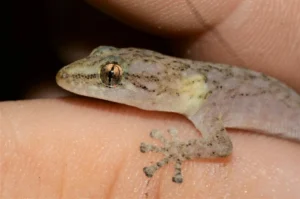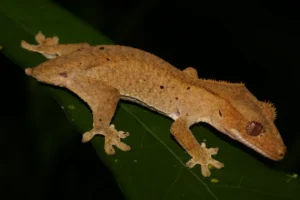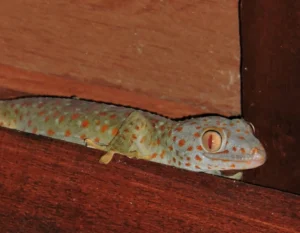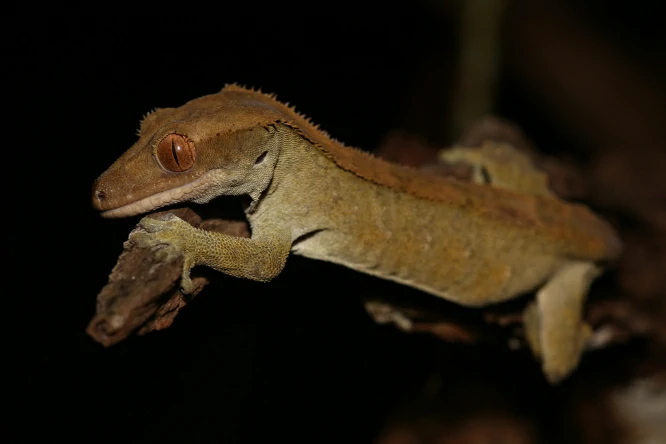If you’ve ever watched a gecko in its tank, you might have noticed it clinging to the ceiling or sides, upside down, sometimes for long stretches. At first, it can look strange or even worrying.
Geckos hang upside down in their tank because their toe pads let them stick to surfaces. This gives them better spots to rest, hunt, and feel safe.
It’s not just a quirky habit. Hanging upside down lets them watch their surroundings, stay out of reach from “predators” like other pets, and grab insects or treats above them.
Some geckos even use it to stretch or control their body temperature near lights or warm spots.
Different Gecko Species Have Different Behaviors
Not all geckos hang upside down the same way. Their habits vary a lot:
-
Crested geckos: Highly tree-dwelling. They love climbing, hanging from branches, tank walls, or even glass ceilings. They spend most of their time off the ground.
-
Day geckos (Phelsuma): Active and agile climbers. They often hang upside down on leaves or tank walls while hunting insects.
-
Tokay geckos: Strong climbers. They use upside-down positions to watch for prey or survey their territory.
-
Leopard geckos: Mostly ground dwellers. They rarely hang upside down, and when they do, it’s usually for short climbs or exploring.
So if your gecko hangs upside down a lot, check its species. What’s normal for a crested gecko might be unusual for a leopard gecko.
Hanging Upside Down Makes Geckos Feel Safe
Geckos are prey animals. Hanging upside down helps them feel safer.

Being off the ground gives them a better view of their surroundings and a quick escape route if needed.
Even in a safe tank, geckos follow instinct. A crested gecko near the top isn’t stressed, it’s just keeping watch.
Tokay geckos often pick high perches to watch their space. It’s a small sense of control in a world that sometimes feels risky.
Hanging Upside Down Helps Geckos Control Temperature
Geckos are cold-blooded, so their activity depends on temperature. Hanging upside down helps them find a comfortable spot.
A gecko might move from a warm floor to a cooler ceiling or hang near a heat source to warm up.
Leopard geckos might stretch toward a ledge near a heat pad. Crested geckos often climb higher to adjust to temperature or humidity.
Sometimes, upside-down is just the coziest spot at that moment.
Watching your gecko move during the day is like watching a tiny temperature-seeking robot.
Lack of Climbing Options Can Make Geckos Hang Upside Down
Here’s an important fact: arboreal geckos like crested or day geckos may cling to glass more than usual if their tank doesn’t have enough climbing surfaces.

Without branches, cork bark, vines, or textured walls, they might explore smooth glass to move around.
This is normal, but too much can sometimes cause problems like Floppy Tail Syndrome (FTS) in crested geckos.
FTS happens when a gecko’s tail base gets strained from long periods of unsupported hanging.
Adding proper climbing structures prevents problems and makes the tank more interesting.
A simple fix: add vertical branches, horizontal perches, and hiding spots at different heights.
Your gecko will use them naturally and spend less time clinging to glass.
Hanging Upside Down Is Exercise
Climbing and clinging upside down is good exercise. Geckos need strong muscles to jump, balance, and move quickly.
In a tank, every stretch, climb, or ceiling-hang works their legs, toes, and tail.

You might see a crested gecko swaying its tail while moving across a branch, or a day gecko carefully reaching for a leaf.
It’s their way of staying active even in captivity. Think of it as a gecko yoga session.
Geckos Hang Upside Down Because of Hunting Instincts
Even pet geckos have strong hunting instincts. Hanging upside down gives them a good view to spot insects or movement.
A tokay gecko on a side wall can see a cricket on the floor and strike quickly. Crested geckos watch tiny bugs or moving shadows.
Day geckos might hang from a leaf, toes gripping, before pouncing on a feeder insect.
Even if you hand-feed them, these instincts make them cling, wait, and strike with precision.
Signs Your Gecko’s Hanging Is Healthy
Upside-down behavior is usually fine. Watch for these signs:
-
Smooth, controlled climbing with no slipping.
-
Alertness and responsiveness.
-
Normal eating habits.
-
Strong tail and leg posture.
If a gecko struggles to cling, becomes lethargic, or refuses food while hanging, that could mean stress, illness, or a tank that needs more climbing structures.
Tips for a Gecko-Friendly Tank
To encourage safe upside-down behavior:
-
Add branches, vines, and cork bark for climbing.
-
Include hiding spots near the top of the tank.
-
Choose a tall enclosure for tree-dwelling species.
-
Use soft substrate on the bottom in case of slips.
A well-set-up tank keeps your gecko active, happy, and stress-free.
Conclusion
So why do pet geckos hang upside down in their enclosure?
It’s a mix of natural instincts, species traits, environmental comfort, and climbing opportunities.
Arboreal geckos like crested, tokay, and day geckos climb and hang for exercise, safety, and hunting. Ground dwellers like leopard geckos do it less often.
Lack of climbing structures can influence this behavior, but providing branches, vines, and hiding spots lets your gecko do it safely.
Hi, my name is Ezra Mushala, i have been interested animals all my life. I am the main author and editor here at snakeinformer.com.

